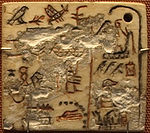
Hand-with-droplets (hieroglyph)
Encyclopedia

Ancient Egypt
Ancient Egypt was an ancient civilization of Northeastern Africa, concentrated along the lower reaches of the Nile River in what is now the modern country of Egypt. Egyptian civilization coalesced around 3150 BC with the political unification of Upper and Lower Egypt under the first pharaoh...
Hand-with-droplets hieroglyph, Gardiner
Gardiner's Sign List
Gardiner's Sign List is a list of common Egyptian hieroglyphs compiled by Sir Alan Gardiner. It is considered a standard reference in the study of Ancient Egyptian hieroglyphs....
sign listed no. D46A is a portrayal of the hand, with droplet offerings. In the Old Kingdom
Old Kingdom
Old Kingdom is the name given to the period in the 3rd millennium BC when Egypt attained its first continuous peak of civilization in complexity and achievement – the first of three so-called "Kingdom" periods, which mark the high points of civilization in the lower Nile Valley .The term itself was...
usage it is found on ivory labels and slab stela
Slab stela
The slab stela was an original form of the steles of ancient Egypt, but in a horizontal dimension. Some of the earliest ones from mid- to late-3rd millennium BC were painted Slab Steles...
s, presumably with the use of 'aroma' and unguents, or with incense. As the verb usage with 'libation', water or liquids are involved.
Usage
The hand-with-droplets hiegoglyph is used as a determinativeDeterminative
A determinative, also known as a taxogram or semagram, is an ideogram used to mark semantic categories of words in logographic scripts which helps to disambiguate interpretation. They have no direct counterpart in spoken language, though they may derive historically from glyphs for real words, and...
for water libations, or the aroma droplets, (or incense) related to unguents. The Egyptian language
Egyptian language
Egyptian is the oldest known indigenous language of Egypt and a branch of the Afroasiatic language family. Written records of the Egyptian language have been dated from about 3400 BC, making it one of the oldest recorded languages known. Egyptian was spoken until the late 17th century AD in the...
usage of the noun
Noun
In linguistics, a noun is a member of a large, open lexical category whose members can occur as the main word in the subject of a clause, the object of a verb, or the object of a preposition .Lexical categories are defined in terms of how their members combine with other kinds of...
, as "incense" or an "incense offering", is id, or id.t, represented as:
Bowstring (hieroglyph)
The ancient Egyptian Bowstring hieroglyph is an Egyptian language hieroglyph associated with the bow, and its use as a hieroglyph for the Archer hieroglyph, a symbol for 'army'...
as a determinative
Determinative
A determinative, also known as a taxogram or semagram, is an ideogram used to mark semantic categories of words in logographic scripts which helps to disambiguate interpretation. They have no direct counterpart in spoken language, though they may derive historically from glyphs for real words, and...
, presumably for its 'strength', and the 'power of unguent aromas'-(i.e. perfume
Perfume
Perfume is a mixture of fragrant essential oils and/or aroma compounds, fixatives, and solvents used to give the human body, animals, objects, and living spaces "a pleasant scent"...
s).
The Egyptian language verb
Verb
A verb, from the Latin verbum meaning word, is a word that in syntax conveys an action , or a state of being . In the usual description of English, the basic form, with or without the particle to, is the infinitive...
form, "to cense, to pour out a libation", spelled as id, idy, has three hieroglyph spellings in the Budge two-volume dictionary.
Pool-lake-basin (hieroglyph)
The "pool-lake-basin hieroglyph" is used in the Ancient Egyptian language hieroglyphs for the alphabetic consonant letter -š.-The Egyptian hieroglyph alphabetic letters:...
as determinative.
A third noun usage is for the word "dew", Egyptian language id. The single form has many spellings with the determinative usage-(or with alternate determinants), and a plural form in hieroglyphs as:
Coptic language
Coptic or Coptic Egyptian is the current stage of the Egyptian language, a northern Afro-Asiatic language spoken in Egypt until at least the 17th century. Egyptian began to be written using the Greek alphabet in the 1st century...
eiote-(five entries), and translated as: dew, mist, vapour, rain-storm, moisture, and exudation, listed under Egyptian language, iad, with some spellings of:
See also
- Gardiner's Sign List#D. Parts of the Human Body
- Hand (hieroglyph)Hand (hieroglyph)The ancient Egyptian Hand is an alphabetic hieroglyph with the meaning of "d"; it is also used in the word for 'hand', and actions that are performed, i.e. by the 'way of one's hands', or actions....

